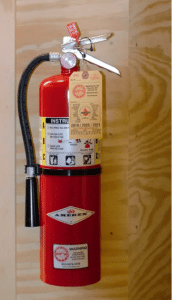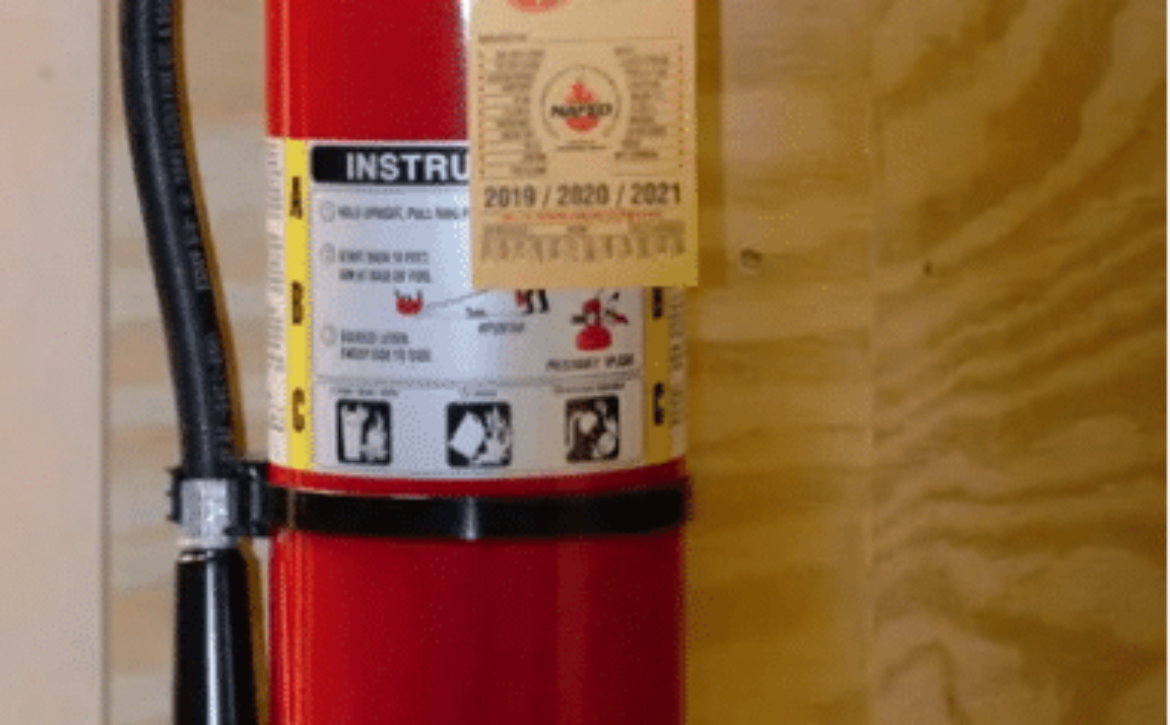Types of Fire Extinguishers & Their Applications
Types of Fire Extinguishers & Their Applications
We all know that our workplace is required to have a fire extinguisher(s) and that everyone should know where the nearest one is located and how to use it.
The issue is, most people don’t realize that a single fire extinguisher doesn’t work on every type of fire. There are different types, or classes, of fire extinguishers the same as there are many different classes of fire.
To ensure true safety for your workplace, you’ll need to have the proper fire extinguisher installed for the potential fire hazards for your building.

Summary Glimpse of Fire Chemistry & Why Class Really Matters
Let’s first take a brief look at the basic elements of a fire.
For our discussion, we will review five classes of fire.
Class A: Freely burning, combustible solid materials such as wood, paper, cloth, etc.
Class B: Flammable liquid or gas, grease, oil, etc.
Class C: Energized electrical fire (energized electrical source serves as the ignitor of a Class A or B fire – if the electrical source is removed, it is no longer a Class C fire)
Class D: Metallic fire (titanium, zirconium, magnesium, sodium)
Class K: Cooking fires – animal or vegetable oils or fats
With all types of fire, the same four elements will always be present:
- Fuel
- Heat
- Oxygen
- Chain Reaction
The Theory as it relates to portable fire extinguishers is that the fire can be quickly extinguished by removing any one or more of these four elements that we’ve listed.
For all classes of fire, the fuel, heat source, and chain reaction varies, which in turn means that there must be different types of fire extinguishers depending on the specific class of fire. For example, a Class A fire can be safely extinguished with just water, a Class C fire cannot, as water conducts electricity and harm to the operator.
6 Different Types of Fire Extinguishers
Now that we’ve discussed the various types of fire and why different fire extinguishers are important, six main types of fire extinguishers and their uses will be reviewed below:
- ABC Dry-Chemical Powder Fire Extinguisher
An ABC dry-chemical fire extinguisher has many advantages as it is a “multi-purpose” fire extinguisher and is, therefore, one of the most common extinguishers to have on hand.
A powder fire extinguisher sprays a very fine chemical powder composed mostly of monoammonium phosphate. This acts as a blanket and suffocates/extinguishes the fire.
These extinguishers are effective for Class A, B, and C fires, since it is not an electrical conductor and since it can effectively break the chain reaction in a liquid or gas fire, something that a water extinguisher is not capable of.
- Carbon Dioxide Fire Extinguisher
A (CO2) carbon dioxide fire extinguisher is one of the cleanest types of extinguishers, as it leaves zero residues and requires no cleanup.
The CO2 fire extinguisher does exactly that – it expells CO2. By doing so, it removes the oxygen from the fire, which suffocates it of oxygen and extinguishes the fire.
- Wet Chemical Fire Extinguisher
The wet chemical fire extinguisher is a specialized type of extinguisher primarily focused on Class K fires, that involve cooking media such as animal and vegetable fats and/or oils in commercial cooking environments.
These extinguishers contain a solution of potassium that effectively launches a double assault on fires.
First, the liquid-mist it sprays acts to quickly cool the fire. Then, a thick soap-like substance forms, sealing the surface of the liquid to prevent any re-ignition.
The wet chemical fire extinguisher is ideal for kitchen settings and Class K fires.
- Water Mist Fire Extinguisher
This is a rather versatile extinguisher, the water mist extinguisher utilizes a newer technology that works across most classes of fire.
This type of fire extinguisher releases microscopic water molecules that fight the fire on a variety of different levels. First, since so much water is dispersed in such a microscopic fog-like form, the level of oxygen in the air is dramatically decreased, which helps to suffocate the fire.
Secondly, the fine water particles are drawn to the fire and, as water always does, it acts to cool the fire reducing the temperature.
Lastly, and maybe most uniquely, the water mist extinguisher is de-ionized (minerals have been removed). Therefore, it can be utilized on electrical fires, as the de-ionized water will not act as a conductor, as well as on burning liquids/gases that standard water extinguishers couldn’t be applied to.
In conclusion, a water mist extinguisher is safe and effective for use on Class A, B, C, and K fires.
- Foam Fire Extinguisher
These fire extinguishers are suitable for Class A and the flammable liquids of Class B fires, although they are not effective in the extinguishing of gaseous fires.
Foam fire extinguishers spray a type of foam that expands when it comes in contact with air and blankets the fire. This helps prevent the vapors from rising off the liquid and feeding the fire, which starves it of fuel. Also because the foam is mixed with water, it has a cool-effect as well.
Foam fire extinguishers are typically one of the best options for liquid fires, such as gasoline fires and polar solvents.
- Clean Agent Fire Extinguisher
Clean agent fire extinguishers are a type of gaseous fire suppression. Stored in its liquid form, when sprayed and it hits the air, it is then converted to its gas form which is non-conductive and leaves no residue.
The gas, often composed of Halon, extinguishes fire by reducing the oxygen levels and disrupting the chain reaction. Because it is non-conductive and so clean, it is perfect for rooms or businesses filled with electrical and/or computer equipment.
Ensure You Protect What’s Yours
Now that you’ve been educated, you can take a look at your property to ensure that you have the correct number and class of fire extinguishers readily available. Please note – there is a good chance (depending on what you are doing) that you might need to have different types of fire extinguishers in different areas of your facility.
Of course, having the proper equipment is vital. However, it is also imperative that the equipment is properly maintained and that your employees are properly trained on how to use the equipment in the event of a fire.
To be certain that you have the correct fire extinguishers in place, as well as the proper training, and to get your fire extinguishers properly checked and maintained for quality and effectiveness, call WFX Fire, Lock & Security today at 855-WFX-1978!
Proper placement and installation add to your overall safety as well as compliance with NFPA and OSHA guidelines. Call WFX at 855-WFX-1978 and ensure your business is properly protected in the event of a fire!
Disclaimer: Any/All information in this article is for informational purposes only. It is believed to be reliable, but WFX Fire, Lock & Security assumes no responsibility or liability for any errors or omissions in the content of this article. It does not constitute professional advice. The user of this article or the product(s) is responsible for verifying the information’s accuracy from all available sources, including the product manufacturer. The authority having jurisdiction (AHJ) should be contacted for code interpretations.


